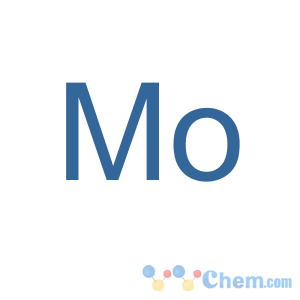Title: Molybdenum
CAS Registry Number: 7439-98-7
Literature References: Mo; at. wt 95.94; at. no. 42; valences 2,3,4,5,6. Group VIB (6). Naturally occurring isotopes: 98 (23.75%); 96 (16.5%); 95 (15.7%); 92 (15.86%); 94 (9.12%); 100 (9.62%); 97 (9.45%); artificial radioactive isotopes: 88-91; 93; 99; 101-105. Its most important ores are molybdenite, MoS2, and wulfenite, PbMoO4. Occurrence in the earth's crust: 1-1.5 ppm. Discovered in 1778 by Scheele; isolated in 1782 by Hjelm. Methods of preparation: L. Northcott,
Molybdenum (Academic Press, New York, 1956) 222 pp; Hein, Herzog, in
Handbook of Preparative Inorganic Chemistry vol. 2, G. Brauer, Ed. (Academic Press, New York, 2nd ed., 1965) pp 1401-1402. Important trace element; participates in biochemical redox reactions such as N2-fixation: Spence,
Coord. Chem. Rev. 4, 475 (1969). Physical properties: Worthing,
Phys. Rev. [2]
25, 846 (1925); D. R. Stoll, G. C. Sinke,
Thermodynamic Properties of the Elements, Advances in Chemistry Series
18, (American Chemical Society, Washington, 1956) pp 23, 130-131. Review of molybdenum and its compds: Rollinson, "Chromium, Molybdenum and Tungsten" in
Comprehensive Inorganic Chemistry vol. 3, J. C. Bailar Jr.
et al., Eds. (Pergamon Press, Oxford, 1973) pp 622-623, 700-742; R. Q. Barr in
Kirk-Othmer Encyclopedia of Chemical Technology vol. 15 (Wiley-Interscience, New York, 3rd ed., 1981) pp 670-682. Biochemical review:
Bioinorg. Chem. II, K. N. Raymond, Ed. (A.C.S., Washington, 1977) pp 353-430. Symposium on the chemistry and uses of molybdenum and its cmpds:
Polyhedron 5, 1-606 (1986).
Properties: Dark-gray or black powder with metallic luster or coherent mass of silver-white color; body-centered cubic structure. mp 2622° (Worthing). bp ~4825°. d 10.28. Spec heat 5.68 cal/g-atom/deg; heat of fusion: 6.6 kcal/g-atom; heat of vaporization: 142 kcal/g-atom (Stoll, Sinke). Fairly stable at ordinary temp; oxidized to the trioxide at a red heat; slowly oxidized by steam. Not attacked by water, by dil acids or by concd hydrochloric acid. Practically insol in alkali hydroxides or fused alkalies. Reacts with nitric acid, hot concd sulfuric acid, fused potassium chlorate or nitrate. Attacked by fluorine at ordinary temp, by chlorine or bromine at a red heat.
Melting point: mp 2622° (Worthing)
Boiling point: bp ~4825°
Density: d 10.28
CAUTION: Potential symptoms of overexposure to Mo metal in exptl animals are irritation of eyes, nose, throat; anorexia, diarrhea, weight loss; listlessness; liver and kidney damage. Potential symptoms of overexposure to soluble Mo compds in exptl animals are irritation of eyes, nose, throat; anorexia; incoordination; dyspnea, anemia.
See NIOSH Pocket Guide to Chemical Hazards (DHHS/NIOSH 97-140, 1997) p 218.
Use: In the form of ferromolybdenum for manufg special steels for tools, boiler plate, rifle barrels, propeller shafts; electrical contacts, spark plugs, x-ray tubes, filaments, screens and grids for radio tubes; in the production of tungsten; glass-to-metal seals; nonferrous alloys; in colloidal form as lubricant additive.

